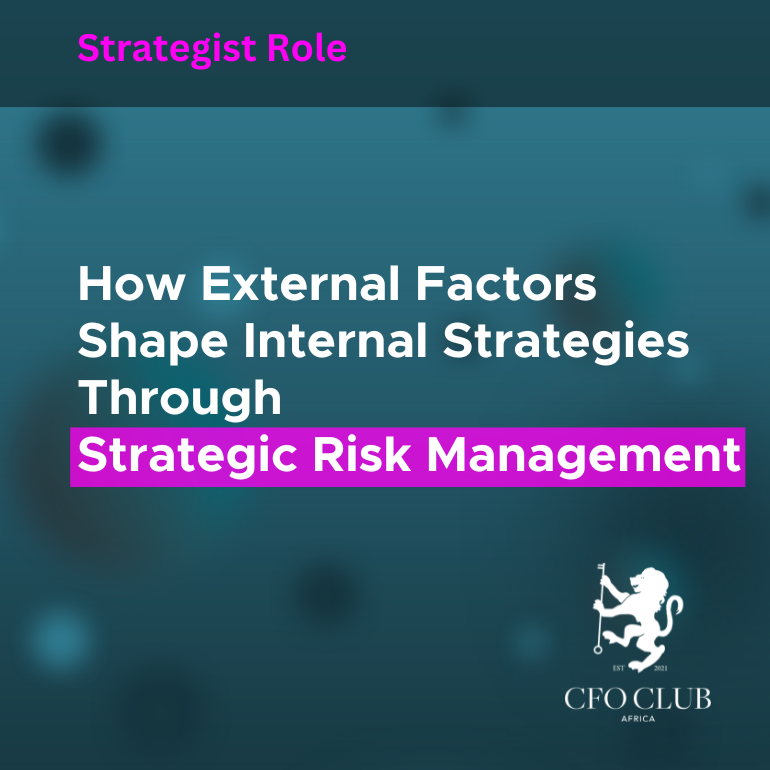How External Factors Shape Internal Strategies Through Strategic Risk Management
Picture this: You’re the captain of a ship in a vast, unpredictable ocean. The skies look clear, but you know the weather can change at any moment—storm clouds can gather, tides can shift, and winds can throw you off course. Navigating your business in today’s world is no different. External forces—whether economic, technological, or social—can quickly turn smooth sailing into turbulent waters. To stay afloat, businesses rely on Strategic Risk Management (SRM), a proactive way to prepare for challenges and adapt their strategies to stay on course.
What Are External Factors?
External factors are influences that come from outside a business and are beyond its control. While companies can’t stop these forces, they must understand and respond to them. These factors shape the environment in which businesses operate and include:
- Economic Pressures: Inflation, recessions, or currency fluctuations can impact costs, pricing, and customer spending habits.
- Technological Advances: Innovations like artificial intelligence or automation can disrupt entire industries. Businesses that fail to adapt risk falling behind competitors.
- Regulatory Changes: Governments often introduce new laws or policies, such as stricter data privacy regulations or carbon emissions limits, which require businesses to adjust operations.
- Global Events: Pandemics, wars, and natural disasters can disrupt supply chains, shift markets, and alter consumer behavior.
- Social Shifts: Changing demographics, consumer preferences, or workplace expectations (like remote work) can affect how businesses operate and serve their customers.
External factors create both risks and opportunities, making it essential for businesses to stay informed and agile.
What Is Strategic Risk Management?
Strategic Risk Management is the process of identifying, assessing, and responding to risks that could derail a company’s goals. Think of it as creating a roadmap that not only anticipates potential detours but also highlights new routes to success.
Unlike traditional risk management, which focuses on minimising immediate threats, SRM aligns risk planning with long-term strategic goals. It’s about preparing for uncertainties while remaining open to opportunities. For instance:
- If a company knows regulations around carbon emissions are tightening, it can invest in greener technologies ahead of competitors.
- If technological advances threaten to disrupt its industry, it can explore partnerships with innovative startups to stay ahead.
SRM doesn’t eliminate risks but ensures a company is better prepared to manage them effectively, turning challenges into opportunities.
How External Factors Shape Internal Strategies
When external forces shift, businesses must respond quickly to avoid falling behind. Strategic Risk Management helps companies translate these shifts into actionable strategies.
The COVID-19 pandemic disrupted industries globally, but the restaurant sector offers a clear example of how external factors can shape internal strategies.
The Problem: Government-imposed lockdowns and health concerns drastically reduced foot traffic to restaurants, threatening their survival. The traditional model of serving customers in-house became impossible.
The Response: Many restaurants turned to SRM to adapt and survive:
- Delivery Services: Restaurants that didn’t previously offer delivery pivoted to online ordering and home delivery, often partnering with platforms like Uber Eats.
- Meal Kits: Some created meal kits, allowing customers to recreate restaurant-quality meals at home.
- Outdoor Dining: Others invested in outdoor seating arrangements to comply with social distancing rules.
Restaurants that quickly adjusted their strategies not only survived the pandemic but often discovered new revenue streams. Delivery and takeaway became permanent parts of their business models, helping them reach a wider audience.
The SRM Process in Action
Strategic Risk Management isn’t just about identifying risks—it’s about managing them in a structured way. Here’s how the process works:
- Spot Risks: Businesses analyse their environment using tools like PESTLE analysis, which looks at Political, Economic, Social, Technological, Legal, and Environmental factors. For example, an auto manufacturer might track changes in emissions regulations or shifts in consumer preferences for electric vehicles.
- Assess Impact: Companies evaluate the likelihood of risks and their potential consequences. This helps prioritise which risks need immediate attention and which can be monitored over time. For instance, a retailer might assess the impact of rising online shopping trends on physical store sales.
- Plan Ahead: Based on the analysis, businesses develop strategies to manage risks. This could include diversifying suppliers to protect against supply chain disruptions or investing in new technologies to stay competitive.
- Monitor and Adapt: The external environment is constantly changing, so businesses must keep an eye on evolving trends and adjust their plans. For example, a tech company might revise its cybersecurity strategy as new threats emerge.
Why Strategic Risk Management Is Essential
SRM isn’t just about avoiding pitfalls—it’s a critical tool for building resilience and driving growth. Here’s why it matters:
- Proactive Adaptation: Businesses that anticipate and prepare for risks are less likely to be caught off guard.
- Resource Efficiency: SRM helps companies focus their resources on the most pressing issues, avoiding wasted time and money.
- Competitive Advantage: Companies that adapt quickly to external changes often emerge stronger, leaving slower competitors behind.
- Long-Term Success: By aligning risk management with strategic goals, businesses can remain steady even in turbulent times.
Final Thoughts
External factors will always challenge businesses, but they also create opportunities for those prepared to adapt. Strategic Risk Management allows companies to navigate uncertainty with confidence, turning potential threats into stepping stones for growth.
Whether it’s a global crisis like the COVID-19 pandemic or a technological shift that disrupts an industry, SRM ensures businesses are ready to steer their ship through any storm. With the right strategies in place, companies can not only weather the waves but chart a course toward long-term success.

